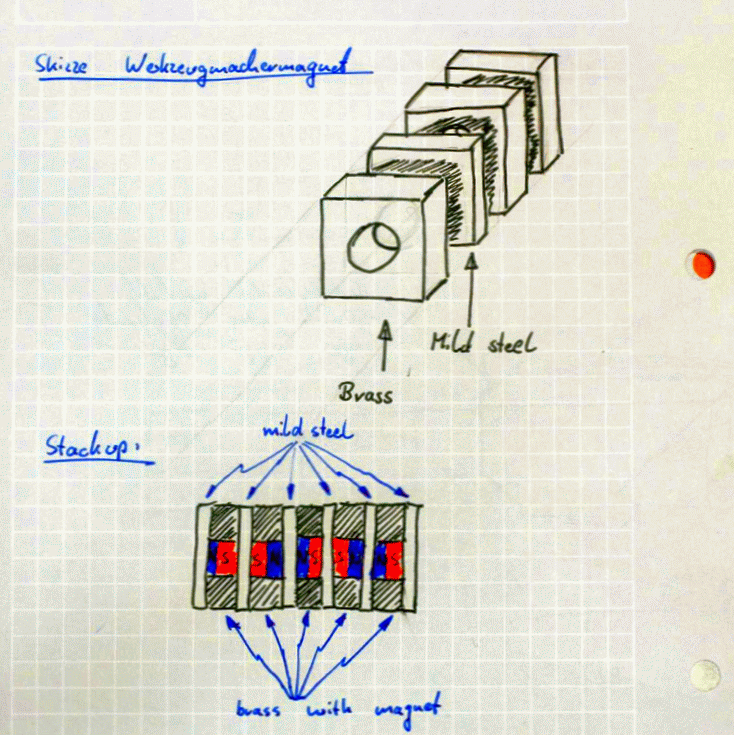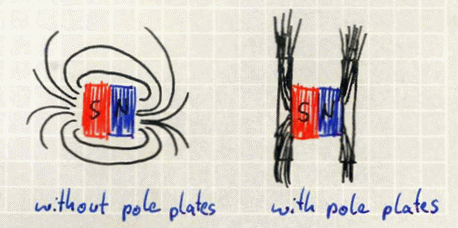So I decided to embed in a piece of brass and have a mild steel pole plate left and right of the magnet, "bending" the field lines to go to the outside of the stack.
Sketch of the stackup, with the magnets orientation:

At work we always had toolmakers magnets - Permanent magnets that where ground all over square, flat and parallel. They where laminated together out of a stack of ferrite magnets and soft iron plates, glued together and enclosed on two sides with brass to hold it together.
The problem with those magnets is the price, a single one 20x20x100mm can cost 200Eur and more.
They can be bought for example from SAV. SAV 424.01
I wanted to make my own by using very cheap neodymium magnets. To do that, the construction had to be changed, as those magnets are not only very bad to machine but they also oxydize when you damage the nickel plating.
So I decided to embed in a piece of brass and have a mild steel pole plate left and right of the magnet, "bending" the field lines to go to the outside of the stack.
Sketch of the stackup, with the magnets orientation:

Here is a sketch of the influence of pole plates to the field lines of a magnet:

There is a two part video series on Youtube showing the whole build process:
Toolmakers magnets - Part 1
Toolmakers magnets - Part 2
I started by squaring up a piece of brass for the magnet holders:
I did not want to transform a whole bunch of brass into chips, so I decided to rip the part down with a slitting saw. It worked quite well, but the sawblade deflected slightly, leaving me with a quite unprecise cut.
I blame the deflection to the fact that the saw was a bit thin, fine pitched and has seen a lot of use in steel:
I finished squaring up the brass, cut it up into single pieces and also prepared the mild steel plates:
This is the stackup I am looking for. In each of the brass plates will be one magnet:
Drilling the brass plates with an 8mm drill:
The grind of the drill - Handground and thinned web:
Here you can see that I took a small oil stone and ground the cutting edge to a neutral 0° rake, so the drill does not get pulled into the brass:
Glueing the stack together with 5 minute Epoxy, the magnets are already in Place. The pole arrangement is NS-SN-NS-SN-NS-SN:
Squaring the magnet up on the surface grinder:
And now, the usual screwup happened ;)
After rough grinding them, I decided to reeinforce them by drilling all the way trough them and glue in a brass rod with loctite 648, so I am not relying on the epoxy itself.
But while I was deephole drilling trough the magnet with a 4mm drill - about 60mm deep, the glue gave away and I was left with two magnets.
I decided not to try to glue them together again and went on with making two, smaller magnets, which are still usefull. I finished the drilling and glued in some 4mm brass rods.
After that minor screwup, I ground the pair of magnets matched to each other:
They can be used as a vice stop:
Or to align workpieces flush to the top of a vice:
They are also usefull to align parts against each other for assembly. For example to put two parts at a right angle and flush to each other:
They have a lot of material left to the magnets, so they can be resurfaced on the grinder a number of times.